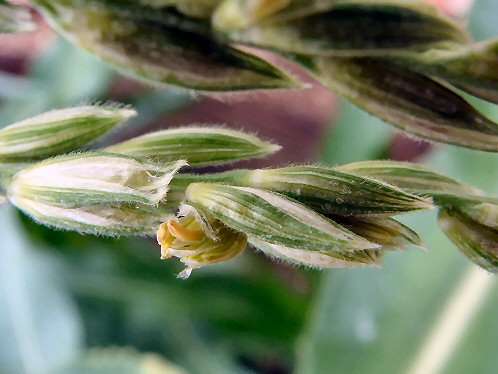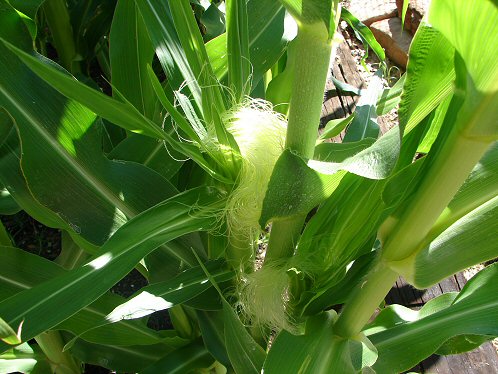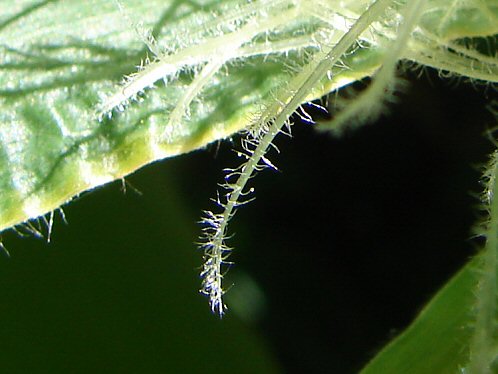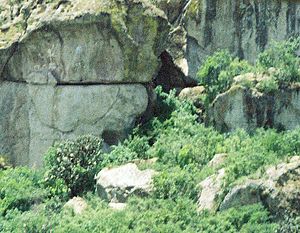Arizona Vegetable & Fruit Gardening
For The Arizona Desert Environment.
Pictures, Photos, Images
Descriptions, Information, & Reviews.
 |
| Male Corn Tassel, Zea Mays. - Photo Taken At Yarnell, Arizona July 29, 2011. |
|---|
 |  |
| Burpee Sweet Corn Bicolored Sugary Enhancer Hybrid Bi-Licious Corn, Zea Mays. Photo Taken July 14, 2011 In Yarnell, Arizona. Four Weeks From Planting. High Quality Corn With Bicolor Kernels. The Ears Grow To 8 Inches Long, Disease Resistant. | Burpee Sweet Corn Bicolored Sugary Enhancer Hybrid Bi-Licious Corn, Zea Mays. Photo Taken At Yarnell, Arizona August 2, 2011. Six Weeks From Planting. Male Tassels Have Formed. Female Silks Have Started To Form. |
|---|---|
 |  |
| Male Corn Tassel. Corn, Zea Mays. Photo Taken At Yarnell, Arizona July 29, 2011. | Male Corn Flower. Corn, Zea Mays. Photo Taken At Yarnell, Arizona August 2, 2011. |
 |  |
| Male Corn Tassel. Corn, Zea Mays. Photo Taken At Yarnell, Arizona August 2, 2011. | Male Corn Flower. Corn, Zea Mays. Photo Taken At Yarnell, Arizona August 2, 2011. |
 |  |
| Unfertilized Female Corn Silk. Corn, Zea Mays. Silks Are White In Color. Photo Taken At Yarnell, Arizona August 2, 2011. | Unfertilized Female Corn Silk. Corn, Zea Mays. Silks Are White In Color. Photo Taken At Yarnell, Arizona August 2, 2011. |
 |  |
| Close Up Female Trichomes or "Hairs" Of Corn Silk. Corn, Zea Mays. Photo Taken At Yarnell, Arizona August 8, 2011. | Close Up Female Trichomes or "Hairs" Of Corn Silk. Corn, Zea Mays. Photo Taken At Yarnell, Arizona August 8, 2011. |
 |  |
| Fertilized Female Corn Silk. Corn, Zea Mays. Silks Start To Turn Brown In Color. Photo Taken At Yarnell, Arizona August 17, 2011. | Fertilized Female Corn Silk. Corn, Zea Mays. Silks Start To Turn Brown In Color. Photo Taken At Yarnell, Arizona August 17, 2011. |
 |  |
| Ready To Eat. Corn, Zea Mays. Photo Taken At Yarnell, Arizona September 2, 2011. | Ready To Eat. Corn, Zea Mays. Photo Taken At Yarnell, Arizona September 2, 2011. |
 |  |
| Ready To Eat. Corn, Zea Mays. Photo Taken At Yarnell, Arizona September 2, 2011. | Ready To Eat. Corn, Zea Mays. Photo Taken At Yarnell, Arizona September 2, 2011. |
Corn It comes to a surprise for most people to learn that corn is in the grass family of plants, but it is! The grass family used to be called Gramineae, but now it is known as Poaceae. It also is a surprise that the "vegetable" ear of corn that we eat is technically considered a fruit!
COMMENTS REGARDING ALL CORN IN GENERAL: A uniquely American contribution to world agriculture, corn (originally maize) is divided into several groups depending on the ultimate use of the grain. Generally speaking there are 3 - 4 types of corn that home gardeners are interested in of the six major corn catagories. Field Corn is planted for livestock feeding. There are many varieties of field corn, some of the most common include dent corn, flint corn, flour corn and waxy corn. Sweet Corn (Z. rugosa) is used for human food when fresh, and can also be frozen. Gardeners are most interested in Zea mays regosa, or sweet corn. Gardeners grow three types of sweet corn and ornamental corn: Sweet corns include sugar (su), sugary enhanced (se) and supersweet (sh2). These types refer to the sugar content and sweet flavor in the kernels when mature. The normal sugary (su) sweet corn converts kernel sugar to starch immediately after harvest. This means the sweet flavor is lost rapidly. Supersweet types were discovered in 1950. They contain more sugar and when dried, the kernels shrank -- thus the name "shrunken two" (sh2). These high sugar types are 'Supersweet' because the sugar level can be twice as great as normal sugary (su) sweet corn at maturity. The supersweet types converts sugar to starch slower so the sweet flavor lasts longer after harvest. Ten years later a new type, sugary enhanced (se) genetic type corn was introduced. The (se) corn has higher sugar levels so the sweet flavor lasts longer after harvest. These (se) sugary enhanced types are very popular because they combine sweet flavor with easy growing needs. Numerous new types of sweet corn are still being developed. Popcorn (Z. praecox) which makes a nutritious natural snack and a fine baking flour. And, Ornamental Corn (Z. indurata), such as, Indian corn, which are grown as ornamentals; and then when no longer wanted as decorations, the ears can be fed to cattle, chickens, or birds. PLANTING AND GROWING CORN::
Preparing the ground for planting corn:
The directions on this page are for the general production of corn. Some species and hybrids may have other requirements. DON'T SOW DIFFERENT TYPES OF CORN TOGETHER. KEEP LOTS OF DISTANCE BETWEEN THEM.
Sow when all danger of frost is over.
Try to plant at least four rows total; (or two raised beds) side by side, for adequate pollination.
SWEET CORN POPULAR VARITIES & PLANTING INFORMATION: Favorite Varieties Normal Sugar: Earlivee, Golden Earlipack, Jubilee Super Sweet: (Should be isolated to insure optimal flavor) Yellow: Super Sweet Jubilee, Sweetie White: How Sweet It Is Bicolor: Phenomenal Sugary Enhanced: (Best series for flavor) Yellow: Honey Buns, Incredible, Miracle, Precocious White: Platinum Lady Bicolor: Double Delight, Breeder's Choice, Honey & Pearls Ornamental: Calico Indian or Squaw Corn, Cutie Blues. Seed Viability (Years) 1 - 2 years. Seed Germination Air Temp: 70-75� F daytime and 60� to 65� nighttime. Soil temperatures for sweet corn: 58-68� F. Soil temperatures for super-sweet corns: 77-95� F. Supersweet types do not germinate well in cool soils. Germination Time Soil Temperatures/Days.
58� to 65� F: 7 to 12 days.
CORN HARVESTING INFORMATION: Pick corn at the milk stage. The only way to really know if your sweet corn is ready to harvest is by pulling back part of the husk and checking the kernels. If milk spurts out of a kernel of sweet corn when you press it with your thumb, the corn is just right. If your fingernail punches into the kernel too easily, the corn is a little green yet. If you must press pretty hard to penetrate the kernel, it is too old. Older ears can be left on the stalk to dry for cornmeal; for eating fresh and freezing, though, you will probably want to pick at the milk stage. Field corn. Field corn can be left to dry on the stalk until late in the fall, harvested by hand, and stored in corncribs over winter. You won't even have to bother shelling your corn before feeding in many cases. When the stalk is dead and brown, walk down the rows and pull off the ears, husking them and tossing them into a wagon or pickup truck alongside the row. Drying popcorn. Popcorn can be harvested by removing the ears from the stalk but leaving the husks attached. The husks can be pulled back and used to tie several ears together, and these can be draped over a wire and hung from a rafter to dry. To keep mice from getting at the corn, poke a hole in a large tin can lid and slide it over the wire. CONTROLLING INSECTS & PESTS THAT THREATEN CORN INFORMATION: INSECT PESTS. The European corn borer and the ear worm both threaten corn crops, but the latter is more severe in the South and central states. Where winter temperatures fall below 0�F. (-17.77*C.), most overwintering ear worms die. The borer often attacks sweet corn, and can be spotted by the presence of a small pile of sawdust like material beside a small hole beneath the tassel. Squeeze the stalk and smash the worm before it has time to crawl down and eat its way into the ear. Corn root worm is a serious pest to commercial growers who plant corn in the same fields year after year. The pest can be controlled by rotation of crops. They thrive particularly in poorly drained soils and during cool, wet spring seasons. BIRD DAMAGE. Birds are a problem, particularly on small plots where they can wipe out the entire planting. You might want to try covering the corn rows with wire until the corn is too high for the birds to bother. ANIMAL PREDITORS. Animal predators, particularly raccoons, usually bother the corn when it is almost mature. Organic gardeners have tried to keep raccoons out of their patches by various methods, some more successful than others. A transistor radio hung in the patch and turned on at night is supposed to keep them away. Leaving a dog tied in or near the patch might also be a good idea if you're having particular trouble. CORN DISEASES & BLIGHTS. Corn diseases and blights can be a serious problem, but they have been partially combatted by breeding more resistant varieties of corn. Some of the molds that rot corn can make you ill, however, so it is good practice never to eat moldy corn or feed it to livestock. Besides a risk of poisoning, moldy corn might be infected with aflotoxins that are carcinogenic. The best defense against corn diseases and blights is to use resistant hybrids and to use clean culture practices. Plow under plant debris, and rotate crops. If you are having problems with an infestation of your corn crop, contact your county agent for more information.
The corn shown growing on this page is:
Burpee Sweet Corn Bicolored Sugary Enhancer Hybrid Bi-Licious Seed produces high quality corn with bicolor kernels. The ears of corn grow up to 8 in. long and are disease resistant.
Use to grow sweet corn as a side dish for meals
OTHER USEFUL HINTS AND SUGGESTIONS. Ornamental Corn - Remember to sow this Corn 2 to 3 weeks after Sweet Corn so they don't cross pollinate. Plant like Sweet Corn, but make sure to leave plenty of room for the large, late-maturing plants. In the South, gardeners build "hills" (low mounds of soil), 3 feet apart. Six seeds are placed in each hill and are eventually thinned to 12 inches apart. Popcorn - Plant 6 to 9 inches apart or in hills 2 to 3 feet apart. As with Ornamental Corn, make sure to sow Popcorn a few weeks after Sweet Corn. Popcorn must be shelled before popping. It is best to shell all your popcorn and store the seeds in tightly closed glass jars in a cool, dry place. If the corn doesn't pop well, it might be because it is too dry. In this case, add a tablespoon of water to every quart jar of popcorn, shake well, and seal for a few days. If corn is still too dry, repeat the treatment. You know when you've added too much water if the corn pops with a loud explosion and the popped corn is jagged, small and tough. Sweet Corn - Sweet Corn is susceptible to damage from frost, but still some gardeners gamble and plant seeds a couple of weeks before the frost free date. Hardier hybrids can come back from a light frost, but prolonged, cold weather can rot seeds, especially those of the super-sweet varieties. Starting corn indoors and transplanting is only recommended in the far North. Where seasons are short, apply a clear plastic mulch as soon as the soil has warmed and plant the seeds through slits cut in it. Direct-seed corn 2 inches apart in rows 2 to 3 feet apart. Cover the seeds with an inch of soil. Where climates are hot and dry, plant seeds 11/2 to 2 inches deep in furrows that have been flooded. Plant this Corn in a block of several short rows. Thin the seedlings 6 to 12 inches apart, depending on the plant size, soil fertility and your ability to keep the corn watered. Few things say summer like sweet corn, picked just minutes before eating. But sweet corn starts converting its sugars to starch the second you pick it, so it's hard to find sweet corn more tasty than that from your backyard. Extra sweet corn can be frozen, canned or parched�dried on the cob and popped with popcorn. Do what the professionals do: Plant early-, mid-, and late-season varieties to ensure the longest season of harvest, several weeks in late summer. Choose from standard sugary (su), sugar-enhanced (se), and supersweet (sh2) varieties with yellow, white, or bicolor kernels. Sweet Corn (Z. rugosa) - Freshly harvested Sweet Corn is so much tastier than store bought corn that it is advantageous to cultivate your own. When the silks of the corn's ear begin to turn brown at their tips, peel back some of the husk to check for maturity. Kernels at the ideal stage for harvest will be milky. Immature kernels are watery; over mature ones are tough and doughy. With a sharp downward twist, break the shank or stem below the ear without breaking the parent stalk. Cook and eat the ears immediately or prepare them for freezing or canning as soon as possible to retain maximum sweetness. Ornamental Corn - This Corn should be planted 2 or 3 weeks after you or your neighbors plant Sweet Corn or the two kinds may cross. Plants are thinned to stand about a foot apart. Ornamental Corn doesn't snap off the stalk easily. Instead of yanking the ears and damaging the stalks, snip them off with shears. If they are for edible use, test for tenderness with your thumbnail. It is ready if a little juice squirts out of the kernel when pierced. Pick them before they turn tough and doughy. If they are wanted for decoration, shuck back the ears and place them in a plastic bag with mothballs for a few days to kill weevils and seed-eating larvae. Sun-dry the ears to dispel the chemical smell. Popcorn - If Sweet Corn has been planted within a quarter-mile radius, delay planting popcorn for 2 or 3 weeks to avoid cross-pollination, which can ruin the flavor of Sweet Corn. Popcorn should be left to dry on the stalk. The ears will shed water better if you break down the stalks as soon as the husks start to dry. If cold weather threatens, snap off the ears, shuck them and dry them on a screen rack in a warm, well-ventilated room. Sprinkle the ears with pyrethrum to discourage seed-eating insects. Sweet Corn - Sweet Corn must have full exposure to sun. Early crops will grow better in fast draining sand or loam. Later crops need the nutrient and water reserves of heavier loam or clay soils. Extremely dry or hot weather or prolonged rain and high winds can affect pollination. Poor kernel development can be a result of nutrient deficiencies. Sweet Corn needs a moderate amount of fertilizer. Early varieties usually need only one preplant application of complete fertilizer plus a mulch of compost. Later varieties are more hardy feeders and therefore need a supplementary feeding when 12 to 18 inches high. Use a 10-10-10 or similar ratio fertilizer. In the South, 13-13-13 plus important micronutrients, is a popular formula. When the silks turn brownish, pull back a strip of husk to reveal a few kernels. Test for tenderness with your thumbnail. Sweet Corn will squirt out milky juice when it's at its best. In the "dough" stage, it's a little overripe, though it's still usable for creamed corn and barbecuing, but it's a little tough for boiling. Pull down and twist the ears to snap them off the stalk. You can control corn earworms and tomato fruitworms by spraying mineral oil on the silks a day or two after you see a dusting of pollen on them. Silks normally detach from fertilized ovules within days of successful pollination and thus can be used as an early indicator of pollination progress and / or success. Silks normally turn brown in color within days of successful pollination and this can be also be used as an early indicator of pollination progress and / or success. Within about 10 to 14 days after pollen shed, developing kernels will resemble white blisters on the corn cob. Cooking Ears Of Corn: Bring water to boil. Drop ears into water. It will stop boiling. When it starts boiling again. It is ready to eat! Some people like to let it boil 5 minutes after it starts boiling again. Cover in butter. salt & pepper to your taste. Enjoy! Click on the following link to see a type of corn from Peru that we are growing. Boy, does it grow fast and tall. It also has a mild taste and is used in Peruvian recipes. Click Here To See, the Giant White Maize Corn, Zea Mays L var. Cuscoensis K. Click on the following link to see a learn about the oldest known use of corn discovered in the Guil� Naquitz Cave, in the Tehuac�n Valley, of Oaxaca, Mexico. Click Here To See, the Guil� Naquitz Cave Article.
Type: Vegetable.
|
 |
| Click On This Photo Of Guil� Naquitz Cave In The Tehuac�n Valley Of Oaxaca, Mexico To Learn About The Oldest Corn About 6,250 Calendar Years Ago. |
|---|
We Are Proud Of Our SafeSurf Rating!
Here Are Some Links To The Very Best & Most Popular Items Sold On Amazon.Com
To Learn More! Click The Links Below. No Obligation, Of Course!
|
|
|---|
| Back To Arizona Vegetable & Fruit Gardening
|
| Back To Arizona Xeriscape Landscaping Main Page
|
| To Arizona Wild Flowers Home Page
|
| Back To DeLange Home Page
Images And Text Copyright Eve & George DeLange.
|




